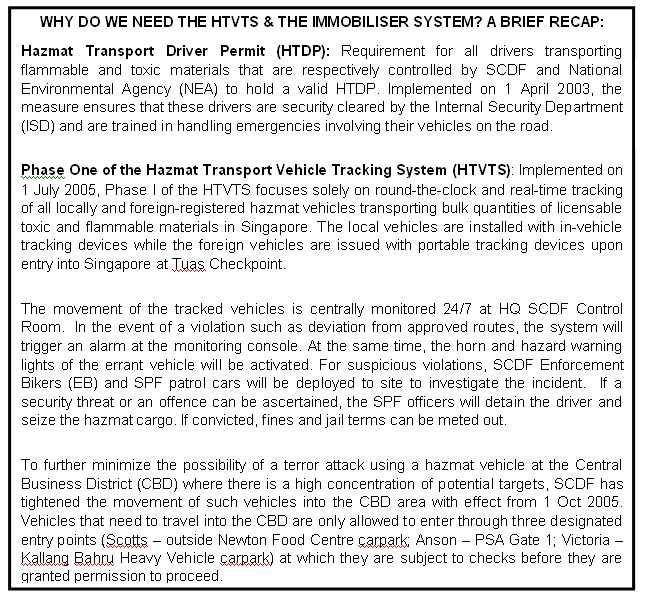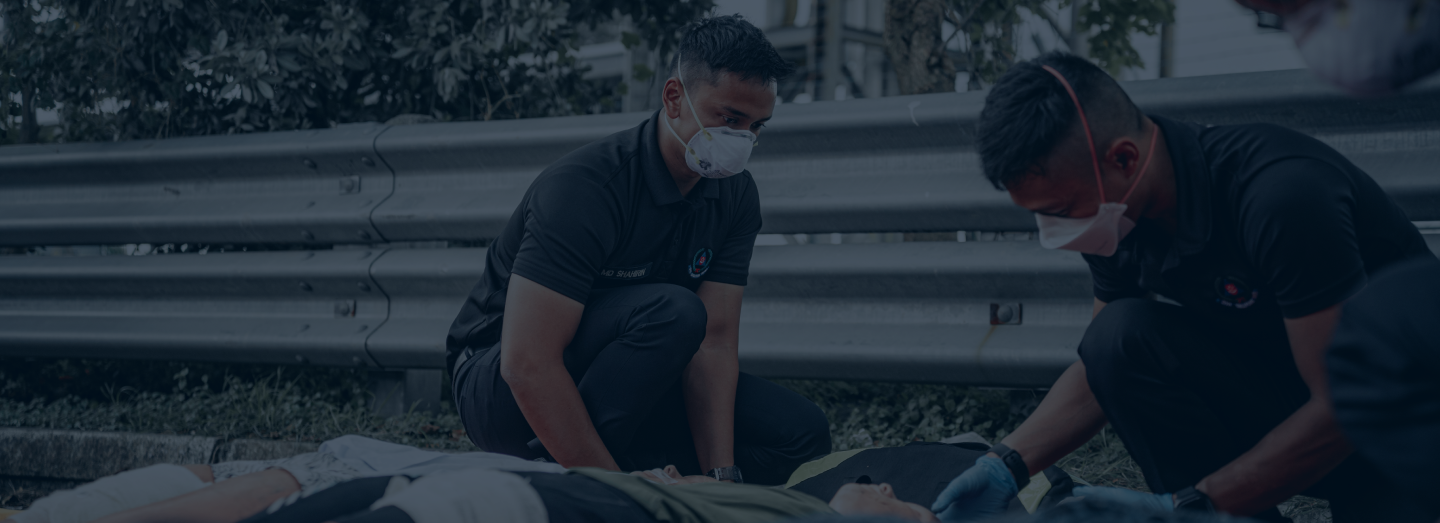Vehicles transporting bulk flammable and/or toxic hazardous materials (hazmat), such as petrol tankers, may be used by terrorists as weapons of mass destruction. SCDF recognises this and since 2003, we have implemented a series of measures to enhance the safety and security of these vehicles. These are namely the Hazmat Transport Driver Permit (HTDP) and Phase I of the HTVTS (See Annex A for more details)
With effect from 1 April 2007, SCDF will embark on Phase Two of the HTVTS which involves the installation of an immobiliser device to all tracked hazmat vehicles including foreign-registered vehicles that need to enter Singapore. This initiative was announced by Associate Professor Ho Peng Kee, Senior Minister of State for Law and Home Affairs, in Parliament on 22 Jan 2007.
The main aim behind the implementation of the Vehicle Immobiliser System is to enable the authorities to have an effective and immediate means to remotely immobilize any hazmat vehicle that has violated transportation rules and is posing a security threat to the vicinity.
THE IMMOBILISER EXPLAINED
The technology used in the Immobiliser System is the "Limp Mode" immobilization which controls the throttle limiters that restrict the fuel injection to prevent acceleration and limit throttle response. This will slow a vehicle progressively without interfering with its power steering and braking system. The process is similar to a deceleration action. The vehicle will be slowed safely to a low speed of 10km/hr to enable the driver to manoeuvre it to the side of the road before it comes to an eventual stop.
 Diagram 1: Flowchart on the Activation of the Immobiliser System |
For road safety considerations, the vehicle"s horn and hazard warning lights will be activated before the immobiliser is triggered. This will alert other road users to avoid the "errant" vehicle that is being progressively slowed down. In addition, while waiting for the enforcement officers to arrive and conduct the necessary investigations, the driver will be required to alight from his or her vehicle and put up a hazard warning sign behind the vehicle,. As part of the system introduction, SCDF has also arranged with the licensed vendor to provide training sessions comprising briefing and hands-on practice for all existing drivers in March 2007, and for all new drivers thereafter.
All in all, some 660 HazMat transport vehicles plying Singapore"s roads will be required to install the immobiliser system. Of these vehicles, 80 are foreign-registered while 580 are locally registered vehicles. A total of 58 Hazmat Transport companies (8 foreign-registered and 50 local registered) currently in operation in Singapore will have to comply with the new Phase of the HTVTS.
VEHICLES REQUIRING THE INSTALLATION OF THE IMMOBILISER SYSTEM
Local-Registered Hazmat Transport Vehicles
Under the Fire Safety (Petroleum & Flammable Materials) Regulations 2005, it is mandatory for vehicles transporting scheduled petroleum or flammable materials whose total net quantity is in excess of three metric tonnes, to be each fitted with an in-vehicle tracking device, approved orange colour-coded vehicle registration plate and an immobiliser system before a transportation licence may be granted.
Vehicles licensed by the National Environment Agency (NEA) to transport liquefied Ammonia, Chlorine, Hydrogen Chloride, Hydrogen Fluoride and Methyl Chloride in quantities exceeding one metric tonne are also required to be each fitted with an in-vehicle tracking device, approved orange colour-coded vehicle registration plate and an immobiliser system. This ruling also applies to vehicles that transport Hydrogen in long tubes (tube trailers), Arsine, Phosphine and Phosgene gases in any amount.
Foreign-Registered Hazmat Transport Vehicles
Every foreign-registered vehicle (carrying specified Hazardous Materials as listed earlier) entering Singapore at Tuas Checkpoint is also required to be installed with an in-vehicle tracking device, approved orange colour-coded vehicle registration plate and an immobiliser system.
TRIALS CONDUCTED
SCDF had conducted several road tests to ascertain the capabilities of the immobiliser system. These tests were conducted at roads under varying conditions and the reactions of the surrounding traffic as well as the speed and feasibility of the immobiliser system were observed. Upon completion of the tests, it was concluded that the activation of the horn and hazard warning lights, together with the immobilization, will alert surrounding motorists to notice and avoid the "errant" hazmat vehicle that is being progressively slowed down.
During the S2006 International Monetary Fund/World Bank Meetings held in Singapore in September 2006, 30 cement mixers that have been granted entry into the construction site at the Marina Bay area were installed with the complete tracking and immobiliser systems for security control reasons. Trial tests conducted on these heavy vehicles have shown the immobiliser to be effective in stopping a vehicle which had traversed out of the designated approved routes.
IMPLEMENTATION SCHEDULE
The implementation will span a one-year period, commencing from 1 April 2007. This allows the companies greater flexibility in scheduling their vehicles for the installation of the immobiliser. The schedule for the installation of the immobiliser has been planned to coincide with the renewal of companies" existing vehicle transport licences so as to minimise inconvenience experienced by the operators.
 |
Companies will receive written reminders from SCDF three months prior to the expiry of their transport licences on the installation requirements. Companies are then required to complete the installation on their licensed vehicles before the transport licence can be renewed. The first batch of vehicles required to carry out the installation will be those with transport licences due for expiry in June 2007. In the meantime, portable tracking devices (available till end March 2008) will continue to be rented to foreign-registered Hazmat transport vehicles coming through the Tuas Checkpoint.
INSTALLATION COSTS
The costs to the industries are as follows:
a. Installation of fixed tracking and immobiliser system: $2900, or
b. Installation of immobiliser device: $1400
All locally-registered vehicles that already have a fixed tracking device will only need to be installed with an immobiliser device. Foreign-registered vehicles will have to install the complete fixed tracking and immobiliser system. The charges for the installation is one-off and a replacement is required only if the device is damaged.
INFORMING INDUSTRIES
SCDF has held dialogue sessions with affected local and foreign operators between 3 and 5 January 2007 to share details on the immobiliser system. During the dialogue sessions, SCDF had explained to these transporters on 1) Purpose for its implementation, 2) Principal technology and its functions, 3) Trial tests being conducted, 4) Operational considerations and safety procedures to adopt upon its activation, & 5) Costs and installation schedule. Panel discussions were also conducted at the end of each session to address the issues and concerns raised. Generally, the industry has expressed support for the implementation of the Vehicle Immobiliser System.
ANNEX A
 |
